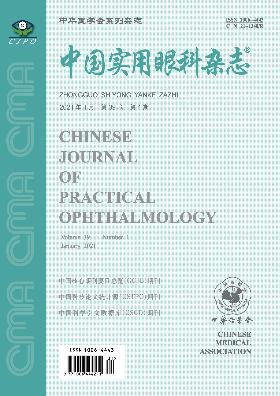Clinical analysis of ischemic syndrome
引用次数: 0
Abstract
Objective To investigate the etiology and risk factors, clinical manifestations, fundus fluorescein angiography, diagnosis and treatment, complications and prognosis of ocular ischemic syndrome (OIS), and to improve the understanding and early diagnosis rate of this syndrome. Methods The clinical data of 16 patients (30 eyes) with ischemic syndrome diagnosed in our hospital from June 2013 to June 2016 were retrospectively analyzed. Fundus fluorescein angiography (FFA), color Doppler ultrasonography (CDFI), and Magnetic resonance Vein (MRV), CT angiography (CTA) and digital subtraction angiography (DSA) were supported the diagnosis. All patients were examined by pathology, visual examination, slit lamp microscope, fundus photography, and FFA. Results Among the 16 patients, 9 were male and 7 were female. The patients’mean age at the time of onset was 60.5 years old (age ranged 60.5±5.5). The main causes were cervical stenosis, cardiovascular and cerebrovascular diseases. Amaurosis fugax was occurred in 2 cases, decreased vision in 11 cases, and eye pain in 3 cases. Conjunctival edema, corneal epithelium and parenchymal edema were observed in 3 cases, anterior chamber placental cells and atrial flash in 1 case, and iris combined with anterior chamber angle neovascularization in 4 cases. Fundus examination showed narrow retinal arteries (29 eyes), dilated but not tortuous veins (20 eyes), and fleck-shaped hemorrhaged of the retina (22 eyes). FFA was performed which showed prolonged arm-retinal circulation time (22.16±6.46 s) and retinal arterial-venous circulation time (14.02 ± 7.26s) in all patients, artery front in 15 eyes, and nonperfusion with peripheral retinal in 6 eyes. CDFI examination showed internal carotid atherosclerotic plaque in 15 cases, internal carotid artery stenosis in 13 cases, internal carotid artery occlusion in 1 case, and internal carotid artery central resistance index slightly increased in 6 cases. Conclusions Clinical manifestations of ocular ischemic syndrome patients are complicated which are depended on the different extents of ischemia. The prognosis of this syndrome is poor. Early diagnosis, early treatment, active control of risk factors and management of complications are the key to determine the prognosis of this disease. Key words: Ocular ischemia syndrome; Clinical characteristics; Treatment; Prognosis缺血性综合征的临床分析
目的探讨眼缺血综合征(OIS)的病因、危险因素、临床表现、眼底荧光素血管造影、诊治、并发症及预后,提高对该综合征的认识和早期诊断率。方法回顾性分析我院2013年6月至2016年6月收治的16例(30眼)缺血性综合征患者的临床资料。眼底荧光素血管造影(FFA)、彩色多普勒超声(CDFI)、磁共振静脉造影(MRV)、CT血管造影(CTA)和数字减影血管造影(DSA)均支持诊断。所有患者均行病理、视觉检查、裂隙灯显微镜、眼底摄影、FFA检查。结果16例患者中,男性9例,女性7例。患者发病时平均年龄60.5岁(年龄范围60.5±5.5)。主要原因为颈椎狭窄、心脑血管疾病。2例出现烟性黑朦,11例出现视力下降,3例出现眼痛。结膜水肿、角膜上皮及实质水肿3例,前房胎盘细胞及心房闪1例,虹膜合并前房角新生血管4例。眼底检查显示视网膜动脉狭窄(29眼),静脉扩张但不弯曲(20眼),斑点状视网膜出血(22眼)。所有患者行FFA检查均发现上臂-视网膜循环时间延长(22.16±6.46 s),视网膜动静脉循环时间延长(14.02±7.26s),动脉前方15眼,周围视网膜无灌注6眼。CDFI检查显示颈内动脉粥样硬化斑块15例,颈内动脉狭窄13例,颈内动脉闭塞1例,颈内动脉中心阻力指数略有升高6例。结论眼缺血综合征患者的临床表现复杂,视缺血程度而定。这种综合征的预后很差。早期诊断、早期治疗、积极控制危险因素和控制并发症是决定本病预后的关键。关键词:眼缺血综合征;临床特点;治疗;预后
本文章由计算机程序翻译,如有差异,请以英文原文为准。
求助全文
约1分钟内获得全文
求助全文
来源期刊
自引率
0.00%
发文量
9101
期刊介绍:
China Practical Ophthalmology was founded in May 1983. It is supervised by the National Health Commission of the People's Republic of China, sponsored by the Chinese Medical Association and China Medical University, and publicly distributed at home and abroad. It is a national-level excellent core academic journal of comprehensive ophthalmology and a series of journals of the Chinese Medical Association.
China Practical Ophthalmology aims to guide and improve the theoretical level and actual clinical diagnosis and treatment ability of frontline ophthalmologists in my country. It is characterized by close integration with clinical practice, and timely publishes academic articles and scientific research results with high practical value to clinicians, so that readers can understand and use them, improve the theoretical level and diagnosis and treatment ability of ophthalmologists, help and support their innovative development, and is deeply welcomed and loved by ophthalmologists and readers.

 求助内容:
求助内容: 应助结果提醒方式:
应助结果提醒方式:


